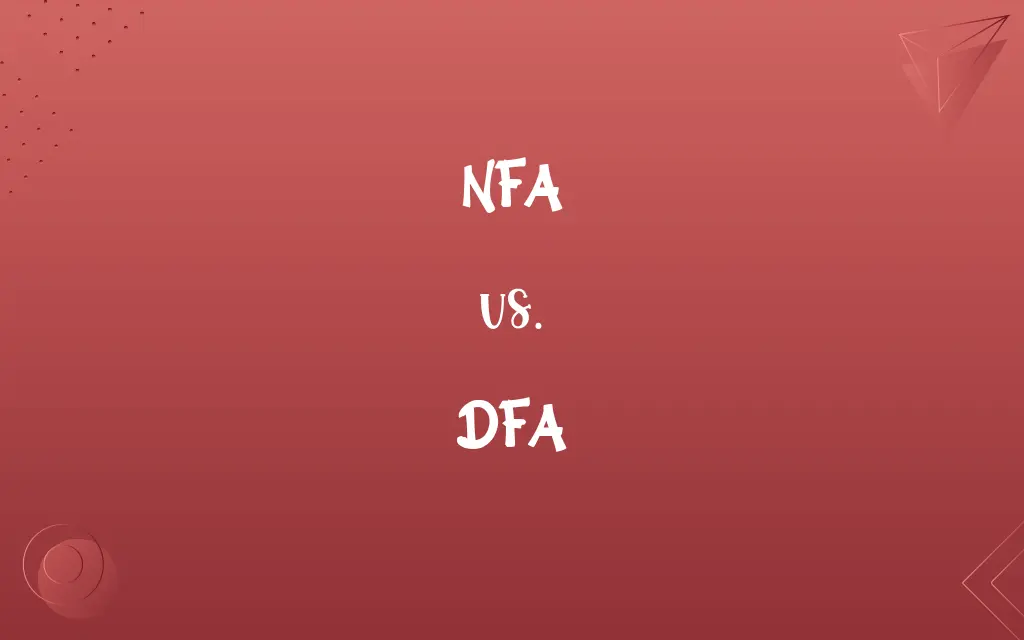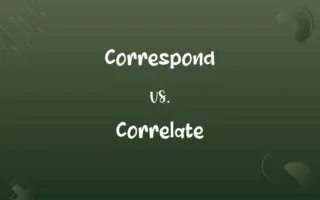NFA vs. DFA: Know the Difference

By Shumaila Saeed || Published on February 24, 2024
NFA (Non-deterministic Finite Automaton) allows multiple transitions for a single input, with non-deterministic paths. DFA (Deterministic Finite Automaton) has only one transition for each input, ensuring a deterministic path.

Key Differences
An NFA, or Non-deterministic Finite Automaton, allows for multiple or even zero transitions for a single input symbol in a given state. In contrast, a DFA, which stands for Deterministic Finite Automaton, strictly allows only one transition per input symbol in any state.
Shumaila Saeed
Feb 24, 2024
In an NFA, computation can branch into several paths for the same input, leading to multiple possible states simultaneously. DFA, however, follows a single path for a given input, leading to a unique next state.
Shumaila Saeed
Feb 24, 2024
NFAs can include ε-transitions (transitions without any input symbol), enabling a jump from one state to another without consuming any input. DFAs lack ε-transitions; each state transition is explicitly triggered by an input symbol.
Shumaila Saeed
Feb 24, 2024
The NFA's flexibility in state transitions often makes it easier to construct but potentially more complex to analyze. DFA's deterministic nature, conversely, leads to simpler analysis but can require more states than an equivalent NFA.
Shumaila Saeed
Feb 24, 2024
An NFA can be converted into an equivalent DFA, usually resulting in an exponential increase in the number of states. This conversion isn't necessary for a DFA, as it is already deterministic.
Shumaila Saeed
Feb 24, 2024
ADVERTISEMENT
Comparison Chart
State Transitions
Multiple or zero for one input in each state.
Exactly one for each input in any state.
Shumaila Saeed
Feb 24, 2024
Computation Path
Can branch into multiple paths.
Follows a single, unique path.
Shumaila Saeed
Feb 24, 2024
Ease of Construction
Generally easier to construct.
More complex to construct due to more states.
Shumaila Saeed
Feb 24, 2024
Conversion to Other Form
Can be converted to DFA (usually more states).
No conversion needed; already deterministic.
Shumaila Saeed
Feb 24, 2024
ADVERTISEMENT
Analysis Complexity
More complex to analyze.
Simpler and more straightforward to analyze.
Shumaila Saeed
Feb 24, 2024
Expressive Power
Same as DFA (equally powerful).
Same as NFA (equally powerful).
Shumaila Saeed
Feb 24, 2024
NFA and DFA Definitions
NFA
NFA can have transitions without consuming input symbols, known as ε-transitions.
An NFA can jump states without reading any input, providing a shortcut in the computational process.
Shumaila Saeed
Jan 17, 2024
DFA
DFA has a unique computation path for every input string, leading to a deterministic operation.
In a DFA, a specific input string always results in the same sequence of state transitions.
Shumaila Saeed
Jan 17, 2024
NFA
NFA may have states with no outgoing transitions for some input symbols.
In an NFA, a certain input symbol might lead to no next state, representing a dead end.
Shumaila Saeed
Jan 17, 2024
ADVERTISEMENT
DFA
DFA is often more state-heavy than its NFA counterpart for representing the same language.
Converting an NFA into a DFA usually results in an increase in the number of states.
Shumaila Saeed
Jan 17, 2024
NFA
NFA is a finite automaton where for some cases, multiple transitions are possible for the same input from a state.
In designing a language recognizer, an NFA can represent multiple possibilities with less complexity.
Shumaila Saeed
Jan 17, 2024
DFA
DFA is widely used in applications like regular expression processing and lexical analysis.
DFAs are employed in compilers for deterministic parsing of programming language syntax.
Shumaila Saeed
Jan 17, 2024
NFA
NFA allows for the acceptance of a language by reaching any of its accepting states.
An NFA can recognize a string as valid if it ends in any one of its designated accepting states.
Shumaila Saeed
Jan 17, 2024
DFA
DFA is a type of finite automaton where each state has exactly one transition per input symbol.
A DFA, used in pattern matching, ensures a single, predictable path for any input sequence.
Shumaila Saeed
Jan 17, 2024
NFA
NFA is often used for theoretical purposes due to its flexibility and simplicity in construction.
NFAs are preferred in theoretical computer science for illustrating concepts due to their non-deterministic nature.
Shumaila Saeed
Jan 17, 2024
DFA
DFA does not allow ε-transitions and requires an explicit input for state transition.
In a DFA-based lexical analyzer, every character of the input precisely determines the next state.
Shumaila Saeed
Jan 17, 2024
Repeatedly Asked Queries
Can an NFA have ε-transitions?
Yes, NFAs can have ε-transitions allowing state transitions without consuming input.
Shumaila Saeed
Feb 24, 2024
What is a DFA?
A Deterministic Finite Automaton with exactly one transition per input symbol in each state.
Shumaila Saeed
Feb 24, 2024
What is an NFA?
A Non-deterministic Finite Automaton where multiple transitions may exist for a single input in a state.
Shumaila Saeed
Feb 24, 2024
Are NFAs and DFAs equally powerful in language recognition?
Yes, both can recognize exactly the same set of languages (regular languages).
Shumaila Saeed
Feb 24, 2024
Why might one prefer using an NFA in theoretical models?
NFAs are often preferred for their simplicity and flexibility in representing various computational scenarios.
Shumaila Saeed
Feb 24, 2024
What makes DFAs more suitable for practical applications?
DFAs' deterministic nature makes them simpler to analyze and implement, especially in programming.
Shumaila Saeed
Feb 24, 2024
How does the computational path of an NFA differ from a DFA?
NFA can have multiple computational paths for the same input, while DFA has a single deterministic path.
Shumaila Saeed
Feb 24, 2024
Is it easier to construct an NFA or a DFA?
Generally, NFAs are easier to construct due to their flexible transition rules.
Shumaila Saeed
Feb 24, 2024
Do DFAs allow ε-transitions?
No, DFAs do not permit ε-transitions; each transition requires an input symbol.
Shumaila Saeed
Feb 24, 2024
Can an NFA be converted into a DFA?
Yes, any NFA can be converted into an equivalent DFA, often resulting in more states.
Shumaila Saeed
Feb 24, 2024
How does the introduction of ε-transitions affect the NFA's power?
ε-transitions add flexibility but do not increase the NFA's ability to recognize more languages.
Shumaila Saeed
Feb 24, 2024
Can DFAs have multiple accepting states?
Yes, like NFAs, DFAs can also have multiple accepting states.
Shumaila Saeed
Feb 24, 2024
How does the complexity of analyzing an NFA compare to a DFA?
Analyzing an NFA is generally more complex due to its multiple possible paths, unlike the straightforward analysis of a DFA.
Shumaila Saeed
Feb 24, 2024
Are there languages that can be recognized by an NFA but not by a DFA?
No, NFAs and DFAs have the same expressive power and can recognize all regular languages.
Shumaila Saeed
Feb 24, 2024
What is the typical use case for DFAs in software development?
DFAs are commonly used in lexical analysis and parsing, such as in compilers and interpreters.
Shumaila Saeed
Feb 24, 2024
Is the conversion from NFA to DFA always unique?
The conversion process is systematic, but the resulting DFA can sometimes be minimized further.
Shumaila Saeed
Feb 24, 2024
Can NFAs and DFAs be used for recognizing context-free languages?
No, both NFAs and DFAs are limited to recognizing regular languages.
Shumaila Saeed
Feb 24, 2024
Can a DFA have states with no outgoing transitions?
Yes, a DFA can have such states, typically representing a dead-end or error in the computation.
Shumaila Saeed
Feb 24, 2024
How does backtracking differ in NFA and DFA?
NFAs inherently support backtracking due to their non-determinism, while DFAs do not backtrack as they follow a single path.
Shumaila Saeed
Feb 24, 2024
Can the state transition diagrams of NFAs and DFAs be visually distinguished?
Yes, NFAs may show multiple arrows for the same input from a state, while DFAs have a single arrow for each input per state.
Shumaila Saeed
Feb 24, 2024
Share this page
Link for your blog / website
HTML
Link to share via messenger
About Author
Written by
Shumaila SaeedShumaila Saeed, an expert content creator with 6 years of experience, specializes in distilling complex topics into easily digestible comparisons, shining a light on the nuances that both inform and educate readers with clarity and accuracy.






































































